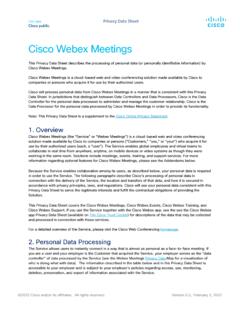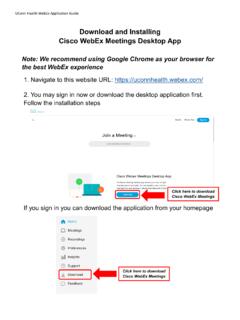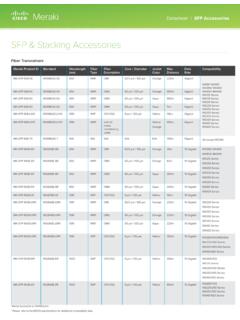Transcription of Cisco Annual Internet Report (2018 2023) White Paper
1 White paperCisco publicCisco Annual Internet Report (2018 2023) Executive summaryThe Cisco Annual Internet Report is a global forecast/analysis that assesses digital transformation across various business segments (enterprise, small-to-medium business, public sector, and service provider). The Report covers fixed broadband, Wi-Fi, and mobile (3G, 4G, 5G) networking. Quantitative projections are provided on the growth of Internet users, devices and connections as well as network performance and new application requirements. Qualitative analyses and assessments are also provided in four strategic areas: applications, security, infrastructure transformation, and empowering employees and Internet adoption and devices and connectionInternet usersNearly two-thirds of the global population will have Internet access by 2023.
2 There will be billion total Internet users (66 percent of global population) by 2023, up from billion (51 percent of global population) in 2018. Devices and connectionsThe number of devices connected to IP networks will be more than three times the global population by 2023. There will be networked devices per capita by 2023, up from networked devices per capita in 2018. There will be billion networked devices by 2023, up from billion in 2018. M2M connections will be half of the global connected devices and connections by 2023. The share of Machine-To-Machine (M2M) connections will grow from 33 percent in 2018 to 50 percent by 2023. There will be billion M2M connections by consumer segment will have nearly three-fourths share of total devices and connections by 2023.
3 Globally, consumer segment s share of total devices and connections will be 74 percent, with the business segment claiming the remaining 26 percent. Internet of Things (IoT) by applicationWithin the M2M connections category (which is also referred to as IoT), connected home applications will have the largest share and connected car will be the fastest growing application type. Connected home applications will have nearly half or 48 percent of M2M share by 2023 and Connected car applications will grow the fastest at 30 percent CAGR over the forecast period (2018 2023). 2020 Cisco and/or its affiliates. All rights paperCisco public 2020 Cisco and/or its affiliates. All rights growthOver 70 percent of the global population will have mobile connectivity by 2023.
4 The total number of global mobile subscribers will grow from billion (66 percent of population) in 2018 to billion (71 percent of population) by devices and connections will be over 10 percent of global mobile devices and connections by 2023. By 2023, global mobile devices will grow from billion in 2018 to billion by 2023 billion of those will be 5G fastest growing mobile device category is M2M followed by smartphones. The mobile M2M category is projected to grow at a 30 percent CAGR from 2018 to 2023. Smartphones will grow at a 7 percent CAGR within the same network performanceAccelerating speedsFixed broadband speeds will more than double by 2023. By 2023, global fixed broadband speeds will reach Mbps, up from Mbps in (cellular) speeds will more than triple by 2023.
5 The average mobile network connection speed was Mbps in 2018 and will be Mbps by speeds will be 13 times higher than the average mobile connection by 2023. The average 5G connection speed will reach 575 Mbps by speeds from mobile devices will triple by 2023. Globally, the average Wi-Fi speeds will grow from Mbps in 2018 to 92 Mbps by pricing (Mobile)The usage per month of the average top 1 percent of mobile users is steadily decreasing. Globally, the top 1 percent of mobile users generated 5 percent of mobile data in 2019. Back in 2010, the top 1 percent of mobile users generated 52 percent of mobile applicationsNearly 300 million mobile applications will be downloaded by 2023.
6 Globally, billion mobile applications will be downloaded by 2023. Social media, gaming and business applications will be the most popular momentumWi-Fi hotspots will grow four-fold from 2018 to 2023. Globally, there will be nearly 628 million public Wi-Fi hotspots by 2023, up from 169 million hotspots in hotspots will grow 13-fold from 2020 to 2023 and will be 11 percent of all public Wi-Fi hotspots by analysisThe number of breaches and total records exposed per breach continue to grow. Globally, there was a 776% growth in attacks between 100 Gbps and 400 Gbps Y/Y from 2018 to 2019, and the total number of DDoS attacks will double from million in 2018 to million by summaryTrendsSection 1: Users/Devices and connectionsSection 2: Network performance and user experienceSection 3: Multi-domain architectureAppendicesFor more informationWhite paperCisco public 2020 Cisco and/or its affiliates.
7 All rights summariesThis section provides regional summaries for Internet users, devices and connections, and network performance. The Cisco Annual Internet Report covers six distinct geographic regions (in alphabetical order): Asia Pacific (APAC), Central and Eastern Europe (CEE), Latin America (LATAM), Middle East and Africa (MEA), North America (NA) and Western Europe (WE). Summary of regional growth rates: Asia Pacific (APAC) -By 2023, APAC will have billion Internet users (72 percent of regional population), up from billion (52 percent of regional population) in 2018. -By 2023, APAC will have billion mobile users (72 percent of regional population), up from billion (65 percent of regional population) in 2018.
8 -By 2023, APAC will have billion networked devices/connections, up from billion in 2018. -By 2023, APAC will have 49 percent of all networked devices mobile-connected and 51 percent will be wired or connected over Wi-Fi. -By 2023, APAC s average fixed broadband speed will reach Mbps, which represents growth from 2018 ( Mbps). -By 2023, APAC s average mobile connection speed will reach Mbps, which represents growth from 2018 ( Mbps). -By 2023, APAC s average Wi-Fi speeds from mobile devices will reach 116 Mbps, which represents growth from 2018 ( Mbps). Central and Eastern Europe (CEE) -By 2023, CEE will have 388 million Internet users (78 percent of regional population), up from 323 million (65 percent of population) in 2018.
9 -By 2023, CEE will have 404 million mobile users (81 percent of regional population), up from 394 million (79 percent of regional population) in 2018. -By 2023, CEE will have billion networked devices/connections, up from billion in 2018. -By 2023, CEE will have 48 percent of all networked devices mobile-connected and 52 percent will be wired or connected over Wi-Fi. -By 2023, CEE s average fixed broadband speed will reach Mbps, which represents growth from 2018 ( Mbps). -By 2023, CEE s average mobile connection speed will reach Mbps, which represents growth from 2018 ( Mbps). -By 2023, CEE s average Wi-Fi speeds from mobile devices will reach 53 Mbps, which represents growth from 2018 ( Mbps).
10 Latin America (LATAM) -By 2023, LATAM will have 470 million Internet users (70 percent of regional population), up from 387 million (60 percent of regional population) in 2018. -By 2023, LATAM will have 520 million mobile users (78 percent of regional population), up from 482 million (75 percent of regional population) in 2018. -By 2023, LATAM will have billion networked devices/connections, up from billion in 2018. -By 2023, LATAM will have 49 percent of all networked devices mobile-connected and 51 percent will be wired or connected over Wi-Fi. -By 2023, LATAM s average fixed broadband speed will reach Mbps, which represents growth from 2018 ( Mbps). -By 2023, LATAM s average mobile connection speed will reach Mbps, which represents growth from 2018 ( Mbps).














